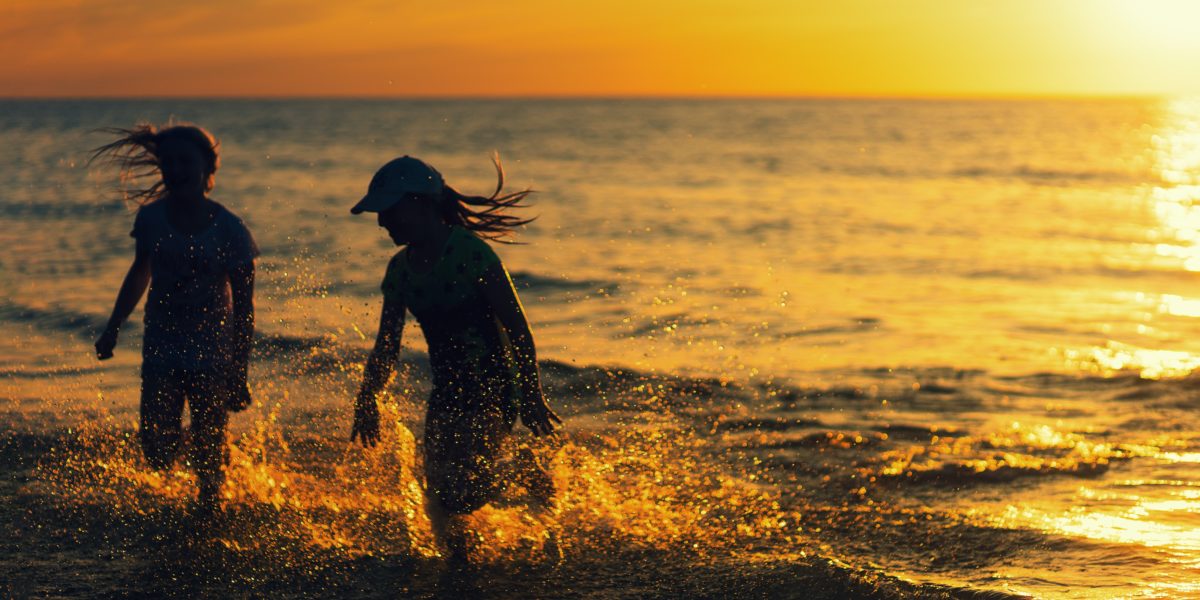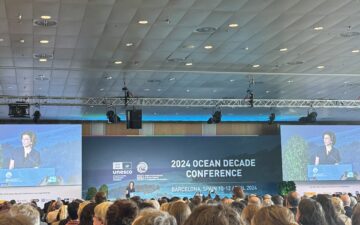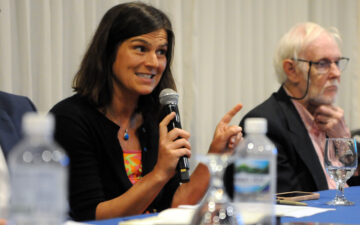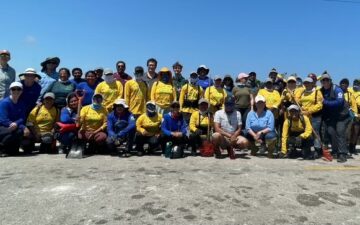For the past few months, we’ve amplified how the ocean offers some of the best solutions to address climate change — while it also presents opportunities to transform our economy.
However, for these opportunities to be realized, we need a healthy ocean. It is possible to restore the ocean’s health by reducing destructive business practices without jeopardizing livelihoods.
In case you missed it, we’re recapping some of the most crucial points from our social media campaign below along with some of our partners who help us #RememberTheOcean and its benefits to our health — and ultimately, our survival.
Want to get involved?
Below are downloadable graphics and social media posts to inspire others to learn, give, and spread awareness. Together, we can make sure everyone will #RememberTheOcean when we talk about climate change.
Get The Toolkit:
Hashtag: #RememberTheOcean
MENTION Us:

The ocean covers 71% of the earth’s surface. But it is one of the least invested areas.
If the ocean were a country, it would represent the seventh-largest economy in the world. Yet, marine conservation and science have been one of the least invested areas of focus in the world. 97% of the Earth’s water is provided by the ocean. But the ocean only accounts for roughly 7% of total environmental philanthropy in the U.S. This is an incredibly small number. Especially when areas closest to the ocean are most susceptible to the consequences of our changing climate.
The ocean is a critical player in regulating climate change.
Blue carbon is the CO2 captured and stored in the form of biomass and sediments by the ocean and its ecosystems. This includes mangroves, salt marshes, and seagrass meadows. Blue carbon is the most effective method for long-term carbon sequestration and storage.
Mangroves alone store about 10 times more CO2 than terrestrial forests. They make up less than 2% of marine environments, but account for 10-15% of carbon burial. As mangroves grow, they take the CO2 and use it as the building blocks for their leaves, roots, and branches. Once the leaves and older mangroves die, they fall to the seafloor and take the stored carbon with them. One acre of mangrove forest can store about 1,450 pounds of carbon per year. This is roughly the same amount emitted by a car driving across the U.S. and back.
Our ocean and climate are inextricably linked.
The ocean is a massive carbon sink, protecting us from the worst of climate change. It also mitigates weather extremes, generates the oxygen we breathe, and produces much of the food we eat. And it is our greatest solution for nature-based carbon capture and storage. In fact, the ocean has absorbed about 30% of the CO2 emitted since the beginning of the industrial revolution.
The ocean also bears the brunt of climate change, and is already experiencing its significant impacts.
More than 90% of excess heat from greenhouse gases has been absorbed by the ocean, resulting in changing temperatures, weather patterns, and sea levels. As our ocean warms, it also disrupts the migrations of key fish stocks and risks the functional integrity of ecosystems.
The increase in atmospheric CO2 leads to a more acidic marine environment, or ocean acidification, that affects the physiological processes for many marine species. When the ocean absorbs more CO2, the level of oxygen in the water decreases and becomes unsuitable for many fish, especially sharks and tuna.
Coral reefs provide food and shelter for 25% of all fish and livelihood for millions of people. But, warming ocean temperatures cause coral bleaching and infectious diseases. Ocean acidification decreases coral growth, and sea level rise can contribute to increased sediment levels on coral reefs, literally choking them to death. Stronger and more frequent storms can also wipe out the corals, and changes in ocean currents interrupt natural ecosystem balances.
The good news is that our most crucial ecosystems can recover if we provide them with healthy conditions.
Nature has always had the best solution, the carbon cycle. Nature-based carbon capture means restoring mangroves and other coastal and marine ecosystems, regenerative agriculture, and reforestation to remove and store CO2 in plants and soils. These nature-based strategies not only diminish environmental and economic injustices, but offer long-term carbon storage as a global benefit. For that, we need to protect the ocean. And we need to do so soon, because these habitats are critical to our long-term survival on Earth.
The Earth’s 175,000 islands are home to more than 600 million inhabitants. These islands are highly vulnerable toward the global challenges we face.
Changing weather patterns, rising sea level, warming ocean, and overconsumption all hit island communities even more intensely. And changes in the marine environment devastate fisheries and degrade the ecosystems many island livelihoods depend on. Small island developing states, like the Bahamas, Haiti, or Fiji, make up 2/3 of the countries that suffer the highest relative losses from natural disasters.
Islands provide homes and livelihood for their inhabitants. They also support the world’s most unique and isolated natural systems and account for much of our global tourism industry. Island-aware policies can help minimize negative impacts of socio-economic and environmental challenges, and preserve travel destinations and homes for millions of people.
The ocean drives global systems that make the earth habitable for humankind.
More than 3 billion people depend on marine and coastal biodiversity for their livelihoods. Without a healthy ocean, not only are those communities in danger, but so is our entire existence.
Our ocean provides us with so much. It is our responsibility to take care of the ocean as much as it takes care of us.
With our donors and partners, we can find global solutions to climate change.
11th Hour Racing
We were proud to help 11th Hour Racing offset their carbon footprint during the 2017–2018 Volvo Ocean Race, and in 2019, we partnered again to conduct a workshop in Jobos Bay, Puerto Rico, about the benefits of blue carbon.
GLISPA
Global Islands Partnership (GLISPA) helps build resilient island communities by inspiring leadership and facilitating collaboration for all islands. We are proud to co-host, with GLISPA, the Climate Strong Islands Network (CSIN) to exchange information, strengthen support, amplify needs, and direct resources and funding.
Grogenics
The mission of Grogenics is to conserve the abundance of marine life by addressing a myriad of concerns for coastal communities. They harvest sargassum at sea to produce organic compost that helps restore living soils by putting massive amounts of carbon back into soil and plants.
Marriott International
We partner with Marriott International on innovative ecosystem restoration and carbon sequestration projects, such as the removal and repurposing of sargassum seaweed. Their goal is to reach net-zero value chain greenhouse gas emissions by no later than 2050 and set science-based emissions reduction targets across all scopes.
Montraville FARMS
Family-owned business Montraville FARMS is based in St. Kitts and uses sustainable agro-technology, infrastructure, and methods to advance food security and nutrition. Through our partnership, they facilitate sargassum removal and insetting at The St. Kitts Marriott Resort & The Royal Beach Casino.
OA ALLIANCE
The International Alliance to Combat Ocean Acidification brings together global governments and organizations dedicated to protecting coastal communities. As an Affiliate Member, we share our perspectives on OA issues to better understand and respond to ocean acidification.
ONORA
A one-stop-shop to easy action items in helping solve the climate crisis, Onora is supporting TOF to help accelerate seagrass restoration projects around the world.
PADI
Inspiring a global community committed to exploring and protecting our ocean, PADI and PADI AWARE Foundation partners with us to offer their community a means of engaging with coastal ecosystem conservation and restoration and reducing their carbon footprint.
Philadelphia Eagles
The first U.S. professional sports team to offset their travel, The Philadelphia Eagles are working with Ocean Conservancy and The Ocean Foundation on seagrass and mangrove restoration in Puerto Rico. They have offset all team travel from 2020.
Sea Going Green
The Ocean Foundation is working with Sea Going Green to identify companies that wish to offset their carbon footprint. Sea Going Green builds successful carbon reduction strategies for private businesses and works with the public sector to build sustainable tourism strategies.
SECORE
We’ll work with SECORE International to restore coastal habitats in the Dominican Republic by replanting corals onto reefs at Bayahibe near Parque Nacional del Este, as part of a 3-year program.
SMILO
The Small Islands Organisation (SMILO) supports communities on small islands of less than 150 km² that wish to work towards managing their territory more sustainably. They aim to curb impacts linked to human activities and development and foster innovations on islands that benefit the local population and environment.
The New York Community Trust
Through the Kraft Fund, The New York Community Trust helps nonprofits in the fight against climate change. We’re grateful for their support of CSIN and the Caribbean Mangrove Coalition, helping U.S. island communities with local solutions for climate resilience.
The Smithsonian
We work with the Smithsonian National Museum of Natural History, Smithsonian Environmental Research Center, and the Smithsonian Working Land and Seascapes initiative on advancing the concept of the blue economy. The Smithsonian plays a leading role in researching blue carbon and the restoration of coastal ecosystems.







